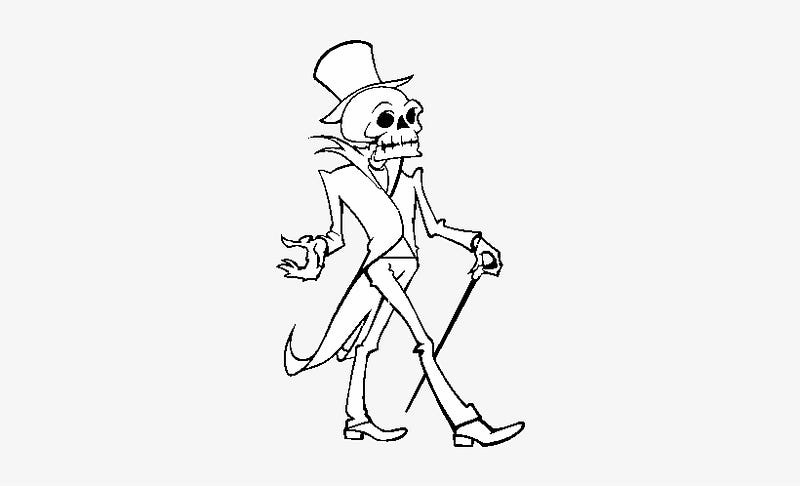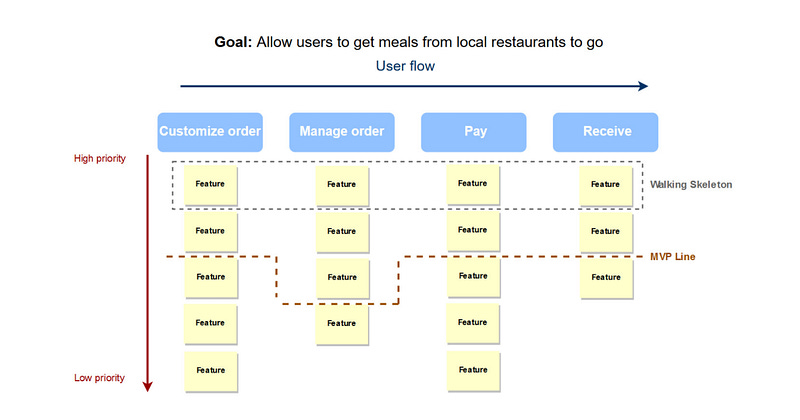Walking Skeleton: The simple prioritization technique for MVPs
The Walking Skeleton prioritization method appeared in the early 2000s. It was advocated by Dr. Alistair Cockburn, an expert in Agile Software Development and often described this method as:
… a tiny implementation of the system that performs a small end-to-end function. It need not use the final architecture, but it should link together the main architectural components. The architecture and the functionality can then evolve in parallel.
A Walking Skeleton is a proof of concept of your basic architectural concept. Where a typically proof of concept focuses more on a single functionality, a Walking Skeleton is a minimalistic end-to-end implementation. A Walking Skeleton is not an outline of your concept, it is really executable and shippable (it can “walk”) and should be accompanied with tests.
Because of the nature of this technique, the Walking Skeleton is used in prioritizing features in Minimum Viable Products (MVP) and defines which of them are absolutely critical for the product to work. Sometimes the Walking Skeleton may be smaller than the actual MVP but it puts the necessary features first.
How does it work?
All of the features are arranged as columns, acting like vertebrae and stories hang down like ribs. This representation allows you to visualize the importance of user stories within certain features and focus on implementing one set of stories at a time.
After you’ve defined the backbone and listed all your main features, you can start prioritizing the stories within each rib. The higher the story is, the closer it is to the backbone, the more important and urgent it is. Stories that are closer to the bottom are less important.
Once you’ve arranged the stories, you’ll see a minimum implementation of your product at the top of the story map. This is what dr. Alistair Cockburn calls a Walking Skeleton: a very minimal but working product that is usually ready for user testing.
Features
The method doesn’t imply requirements falling into certain categories. However, it has distinct features that focus on user stories.
Key features first. When using the Walking Skeleton, a delivery team ranks the necessary user stories first.
The system must function. Due to the focus on the implementation of the essential points, the key functionality forms a fully operational product, without any additions.
Reflects the business concept of a future product. The Walking Skeleton advocates showing business value. That is why the story maps are lined up to display the core system elements within the restricted technical basis.
Completed with tests. Since the Walking Skeleton involves the whole production pipeline, including delivery and deployment, the testing is applied as well.
Pros of Walking Skeleton
Fast prioritization. One of the key benefits of Walking Skeleton prioritization for stakeholders is that defining the core features won’t take much time.
Key functionality only. When estimating the business value of a future product, it’s often hard to focus on the core element, as there’s always a temptation to make it as comprehensive as possible. The Walking Skeleton helps avoid this situation, putting the operating MVP with the greatest validity first.
Fast market validation. Arguably one of the most significant advantages of the Walking Skeleton is that its prioritization results help to quickly get feedback from users. Therefore, the stakeholders assess the product-market fit and the business idea as a whole. In further releases, they can suit it up.
Cons of Walking Skeleton
Lacks important functionality. While the basic working framework is included, the Walking Skeleton will not involve other additional though still important features. It might play a critical role at some point.
Late first release. Although the Walking Skeleton is a rather quick prioritization technique, the first release won’t be fast as you still must ship a functioning product.
The risk to cut corners. When trying to roll out the basic version of a product as fast as possible, the stakeholders may try to refuse the basic functional features to accelerate the release. That is why when prioritizing the backlog, the team should focus on keeping the basics without omitting them in favor of fast delivery. Otherwise, the very first — and viable — product version is at risk of turning into a prototype that is not ready for the market.
When to use
The main goal of the Walking Skeleton model is to ensure that the MVP will eventually “walk”, meaning, it will function in accordance with the requirements. Thus, if you evaluate the features of this model, you will need to identify the following:
The must-haves that make the system work
The ones that should be there in correspondence with the requirements
The ones that resonate with the business goals and values
The ones that passed the tests
If you select and realize these features, you will receive a functioning MVP as an outcome. On the other hand, this model does not imply delivering a more sustainable and complex product with numerous extra features or additional business value, so you will have only bare functionality at your disposal. For the latter, the stakeholders should consider something more comprehensive and detailed.
Via:



